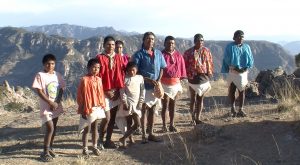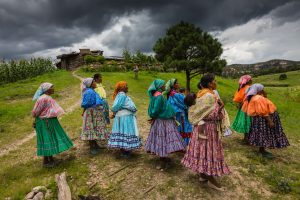Tarahumara people of Copper Canyon region, which is often called “Sierra Tarahumara” because of its reputation as the home of significant Tarahumara population, have been living in the treacherous terrains of northwestern mountains of Mexico for nearly five hundred years. Ever since the Spaniard came to their original homeland, the region which is now referred as “Free and Sovereign State of Chihuaha”, Tarahumara people moved deep into the Sierra Madre Occidental, thus avoiding direct clash with Spanish conquistadors. Since they have migrated to one of the deepest regions of the Sierra Madre, Tarahumaras became one of the not so many indigenous groups in Mexico who managed to fully preserve their pure ancestral cultures and customs barely touched by Spanish influences. The Jesuits could not manage to fully convert them to Christianity, with quite a lot of Tarahumaras still practicing their indigenous religions barely changed. Even their very existence was largely unknown until 1993, when a group of American photographers convinced a few local people to participate in 100-mile ultramarathon held in America. One of their most renowned and well-known feat that is closely related to their tradition, is long-distance running, with every single member of the tribe being able to run hundreds of miles and hundreds of kilometers for days without stopping. Even their name come from the Spanish corruption of their name in their native tongue The Raramuri, which means “light runners”, or “the ones with light feet”.

The male runners of Tarahumara tribe, photo courtesy to http://imgarcade.com/tarahumara-runners.html
But as of the dawning of the twenty-first century, when the entire country of Mexico has been plunged into nationwide drug warfare between US-Mexican law enforcement forces and drug cartels, Tarahumara tribe started to face one of the biggest challenges to their identity and safety – the drug cartels and illegal narcotics industries. Most of the accounts and testimonies from Tarahumara victims of the illegal drug industry point out that the drug cartels have been extorting and threatening the locals to work for them since the mid 2000s’, which coincides with the beginning of the Mexican Drug war which started in December 2006. Since then, quite a lot of Tarahumara people have been the victims of labour exploitation and violent attacks from the drug cartels. One of the biggest reasons they became easy target for drug cartels is that they live in close proximity with the Sierra Madre regions, one of the largest drug producing regions in the entire Mexico. They also found great usefulness in Tarahumara tribesmen’s long-distance running abilities, high stamina and great endurance forged from centuries of living experience in harsh mountain regions. And compared to other means of transportation and delivery, Tarahumara people are much cheaper and less likely to be detected by the law enforcement officials. They are cheap because they usually do not demand wage increases and higher standards of employment, due to fears of receiving personal vendettas from murderous drug cartel leaders and their assassins. Tarahumara people were considered to be highly resilient cheap laborers who can smuggle the products into faraway regions not only in Mexico but also in Southern parts of United States such as New Mexico Desert.

Female members of Tarahumara tribe, courtesy to http://www.landscapes.org/glf-2014/?contestants=sierra-tarahumara-mexico
It is impossible to figure out the exact number of the Tarahumara people who are being forced to work for drug cartels and narcotics producers, since there have been no official consensus report of neither the total population nor the victimized population of Tarahumara tribe. Their traditionally reclusive nature, extremely rough and dangerous terrains of the local environment and complex power dynamics between local authorities and drug cartels are hindering many efforts to create reliable statistics of the exact number of Tarahumara populace and the extent of the victimization of Tarahumara tribe by the drug cartels. Most of the articles and documents which write about the exploitation of Tarahumara people by illegal drug industries are relying on eyewitness accounts by the locals and actual interviews of the former Tarahumara narcotics workers who were either convicted in United States and Mexico for drug smuggling, or luckily escaped into outside world to tell the stories. Private investigators, journalists and indigenous peoples rights activists are also finding it extremely hard to figure out the way to help certain Tarahumara people who have been essentially enslaved by the cartels, for their homeland is located in Sierra Madre, one of the most prominent drug producing region in the Mexico. Although the drug industries are not the only problem which threatens the existence of Tarahumara people, their plight remains to be one of the tragically unexplored territory of the tragedy of Mexican Drug War.
http://www.excelsior.com.mx/nacional/2015/04/09/1017872
*The video link above, which is allegedly filmed by one of the cartel convoys, in November 2014 in Copper Canyon (Sierra Tarahumara) when there were several confrontations between groups of organized crime, features cartel militants operating in the region Tarahumara people live.
Goldberg, Ryan. “The Drug Runners.” Texas Monthly, July 2017. Accessed September 24, 2017. https://features.texasmonthly.com/editorial/the-drug-runners/?src=longreads
Roston, Aram. “MEXICAN DRUG WAR’S NEXT VICTIMS: TARAHUMARA INDIAN RUNNERS.” Newsweek, June 25, 2012. Accessed September 24, 2017. http://www.newsweek.com/mexican-drug-wars-next-victims-tarahumara-indian-runners-65101.
